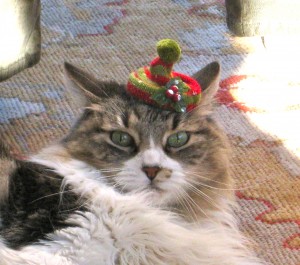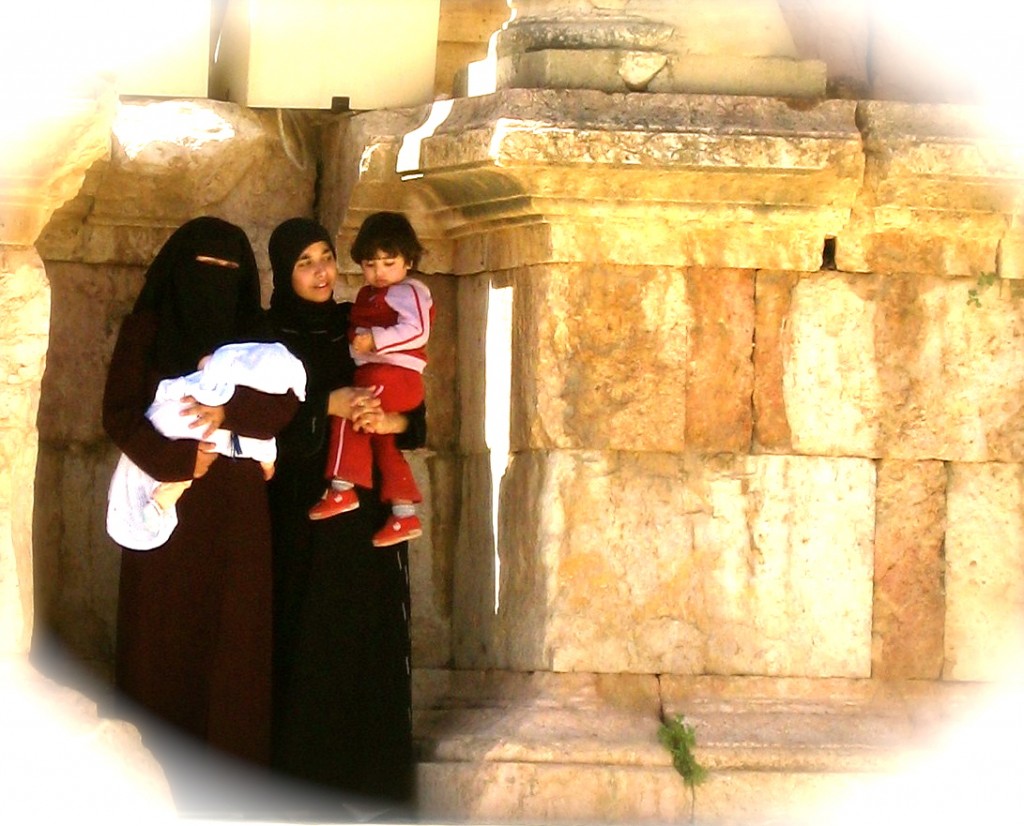Category: Blog1
 The holidays are upon us. Even the cat is enthused.
The holidays are upon us. Even the cat is enthused.
When the children were young, I was overwhelmed. As Mom, Wife, Daughter, Sister, Aunt, Employer, Supplier, Neighbor, and Friend, I finally learned to say, “no, thank you” to all but essentials.
I started shopping in June and finished by early November. I paid cash, easier because I spread the outlay over five months. I refused to set foot in the mall after mid-November unless coerced into seeing decorations outside of Neiman-Marcus. My Christmas cards were addressed before the turkey went into the oven for Thanksgiving, and they dropped in the mail box on December 1st.
It took five years to devise this plan, which evolved when I realized this most holy and supposedly peaceful time had become total carnage. The people whose holidays I enhanced enjoyed themselves immensely, but I reached mid-December looking as if I had fallen off of the sleigh en route without a parachute.
It’s been sixteen years since I instituted my holiday regime. No one’s been deprived and everyone’s received the gift of my good cheer. Not only did I owe those around me a more civilized approach to the season, I owed it to me.
Restraint was the gift I gave myself. And it’s an especially important gift for those of us on whom so many rely. We deserve a little Christmas joy, too. But more especially, we need to remember that the season is about the peace of Christ.
Embrace His grace.
(This is my most popular blog post ever, and I’m sharing it as I work my way back from Thanksgiving. Before you go further, let me warn you this is opinionated.)
 My twitter and Facebook following grows daily— over 50,000 amazing individuals now! As part of the platform-building process, I monitor the people who follow me, ensuring they don’t repeatedly offend my core demographic, which leans right.
My twitter and Facebook following grows daily— over 50,000 amazing individuals now! As part of the platform-building process, I monitor the people who follow me, ensuring they don’t repeatedly offend my core demographic, which leans right.
My friends in daily life represent diverse preferences, come from all walks of life and belief systems (almost), and are a great group of humans. They are each uniquely marvelous, and I am thankful for every one. I hope my twitter followers, blog readers, and Facebook “friends” are the same.
But my real-life friends also are well-behaved. They understand the importance of presenting themselves professionally, monitoring their mouths, and acting with grace and polish. They know their electronic presence develops an image vastly more far-reaching than their real-life reputation, and recognize bad behavior can harm them, and limit their futures.
So what’s the deal with airing sarcastic, profane, angry rants in public? I am so confused.
Dinosaurs roamed the earth when I was in college, but my profs taught about institutional marketing. It’s now called “branding,” but it’s how an entity is positioned in the public eye. Apple and Starbucks are two examples of formidably effective institutional marketing; British Petroleum and AIG (most disliked corporation in America in 2012) are not.
Every facebook post, blog entry, and tweet is a piece of institutional marketing. It’s either going to hurt you, or help you— and you control which it does! It’s going to make you look talented and conscientious, or it’s going to convey failure and futility. The electronic data congeals into an image — a brand — that facilitates more accomplishment, or condemns an endeavor to fail.
I don’t know about you, but tossing information into the great Internet abyss is scary enough. Posting snide negativity and sharing combative dirt from daily life appears suicidal to me. There’s just too much at stake, and too few second chances in cyberspace.
Who can afford to be a tweeting twit?

Two hundred yards north of my office, a failing fence line from the original ranch marks the beginning of BLM (Bureau of Land Management) land that runs unimpeded to the next state. Several hundred thousand acres provide habitat for bear, mountain lion, elk, deer, turkey, fox, and only God knows what else. It’s really a wild wonderland out there.
Two months ago, pops of rifles being sited in for hunting season rolled up the small valley I see from my office. The season is tiered, with the most difficult hunts first: black powder (the old muzzleloaders used by those wanting an authentic experience); bow hunting; and lastly, rifle. Concurrent with the pops, vehicles appear along the interstate highway as it crests the pass; hunters scout game and stake territory for their annual adventure.
It’s important to note I don’t know a single hunter in our valley who hunts exclusively for the fun of it. They eat what they harvest. Share it with friends and family. It’s not a mad rush for a nice set (“rack”) of antlers on the wall, but rather a tradition that yields a healthier alternative to meat purchased in our local grocery store. (We won’t go there.) My family doesn’t eat venison (deer), so we don’t hunt it. Fortunately for the elk, which we love, we’re on the wrong side of the valley because they prefer high timber on the nouth-facing slopes that catch most of our summer rain.
But it’s interesting that our yard traffic increases as hunting season escalates. More does and fawns (full of energy because they’re big and strong now) visit. A bachelor party of six young bucks dropped by last week before an unleashed neighborhood dog chased them away. The daily migration of cloven beasts becomes a parade I enjoy when movement catches my eye.
Every once in a while, a truly amazing creature saunters confidently through the meadow. Full of his manly self, ignoring his lessers, I’m convinced these loner bucks know they’re safely on private land. Each one hangs out for a few days until someone bigger pushes him over the ridge into harm’s way.
The blaze-orange dots—hunters—bobbling on the dangerously sloped mountainside two miles north have no idea what’s ten feet outside my dining room window. But the deer and I watch each other for a few minutes before I resume my work, and they finish mowing the last of the summer lawn.
[subscribe2]
Every summer, the ranch-gate culvert housed a den of foxes. We’d see them shortly after we arrived in late May, then hear them for three months as they circled the house after nightfall, yipping and howling for attention and food. (The nocturnal symphony included yodeling coyotes, one mountain lion roar, and unidentified noises guaranteed to scare the bejeebers out of visiting city kids.)
Mama Fox, whom someone named Fanny, was an attractive vixen, a fixture in our glacial-moraine valley. Her kits‚ goofy with spindly red legs and tall black knee socks, grew rapidly to mark the passage of a fleeting season. They were a tradition.
Foxes on this mountaintop where I now live are a half mile away, tucked in a ravine. Distant neighbors at best. But we have Isabella.

She is a graceful creature with the face of an angel. I first saw her bedded down four feet from me, on our east slope in a tight aspen grove. She enjoyed a sunny patch where 800 daffodils would bloom sixty days later. The tiny, spotted fawn had a perfectly symmetric white face, very unusual and distinctive. And her eyelashes would make a supermodel jealous. I could see them from the dining room! When I posted her photo, a friend said she was so beautiful that her name must be Isabella.
The early spring of her youth led to summer, then a less-brutal winter, and finally another warm season. I had forgotten about her except when I happened across her image during iPhoto housekeeping.
But after our fourth snow of the season, I pulled into the drive to find deer munching wildflower shreds. One looked up and—voila! The white face. The long lashes. The peaceful visage. She had grown from a beautiful fawn into a lovely doe. I got out and rounded the corner for a better look. She delicately nipped her way to the edge of the meadow, glanced at me over her shoulder, and sashayed down the hill.
Long live Isabella!
(Shakespeare is turning in his grave, but he’s been loosely quoted before. And be warned this is an opinionated post.)
 I tweeted today (http://aje.me/ZzCsCn) about Yemeni women struggling with tradition versus rights. Then I remembered my generation hasn’t been without evolution, so reminded myself not to take a Western, superior attitude toward struggling Middle-Eastern sisters.
I tweeted today (http://aje.me/ZzCsCn) about Yemeni women struggling with tradition versus rights. Then I remembered my generation hasn’t been without evolution, so reminded myself not to take a Western, superior attitude toward struggling Middle-Eastern sisters.
I was fortunate to be a teen of the 70’s—great music, greater prosperity—and probably am one of few who remember the decade clearly. ( I didn’t “drink the Kool-Aid.”) Growing up in a conservative Christian denomination, I knew ONE female college professor, ONE piano teacher, and ONE nurse. Everyone else was a wife and/or mother—exclusively. Professional role models were scarce as after-service smokers on the church’s front porch. (Wait—there were actually more smokers.)
Gloria Steinem and Bella Abzug were revelations; a career AND husband AND children were epiphanies. The glass ceiling (anyone remember that?) beckoned, glistening just out of reach until I crashed through it with enough momentum (good thing I have a hard head) its shards could fill the Milky Way.
What happened? America became prosperous. Our culture stigmatized “working mothers.” Many quit their jobs the moment a husband made enough money to support the family, dedicating themselves to tennis, Junior League, or helicoptering kids.
What did we teach our daughters in the process?
My children attended a swanky college-preparatory school with classmates whose family’s names are recognized globally. A lot of privilege, money, heritage and entitlement flooded those waxed hallways. But you know what’s interesting? Of my son’s graduating class, all but one of the top ten students had working mothers. And my daughter’s class mimicked the ratio. Coincidence?
I believe their generation (particularly girls) learned work ethics from moms. Dads were at the office, or largely somewhere else, unobserved. But if Mom was home—if they saw her struggle to balance work and parenting, if they bore the condescendion of her being unable to work the school lunch line because she was making money—they developed priorities to sustain and propel them through rough adult years ahead. She was a scrappy role model for adult life both in and out of the home.
Some Western women are little more than privileged burka-wearers. And I’m still picking glass from my hair.[subscribe2]
 The holidays are upon us. Even the cat is enthused.
The holidays are upon us. Even the cat is enthused.


